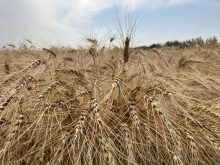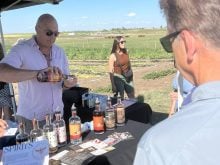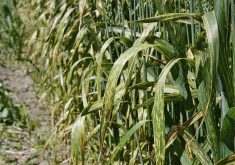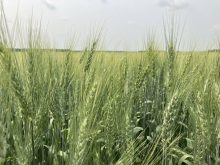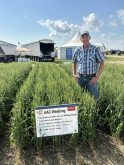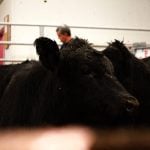Stripe rust continues to spread through commercial winter wheat fields. It has now been reported in southern Alberta by Dr. Denis Gaudet (AAFC-Lethbridge), in Lacombe/Red Deer/Olds by Dr. Kequan Xi (AARD-Lacombe), in Whitecourt/Edson (anonymous) and all the way up in Beaverlodge by Dr. Kelly Turkington (AAFC-Lacombe). Stripe rust at the levels observed, and at the crop growth stage at onset in many areas of the province, including the Peace region, are quite significant. Some speculate that perhaps the 2014 outbreak resulted from the pathogen overwintering on winter wheat in several locations across Alberta. This has not yet been confirmed and it is possible that rust spores may have been carried to Alberta from source locations in the Pacific Northwest of the United States of America.
Read Also

UCP government throws Corb Lund’s anti-coal petition a curveball
With the passing of Bill 14 by Alberta’s United Conservative Party provincial government, country singer Corb Lund’s anti-coal mining petition has been cancelled retroactively.
Drs. Kequan Xi and Krishan Kumar (AARD-Lacombe) reported last week that significant levels of stripe rust were seen in a few spring-seeded wheat fields in the Lacombe/Red Deer/Olds region. They also reported some barley fields with significant and potentially damaging levels of scald disease. As well, tan spot is appearing in some wheat fields in southern Alberta. Scouting of spring cereals for stripe rust, and other leaf diseases is urgently recommended all across the cereal production areas of Alberta.
- More from the Alberta Farmer: Southern Alberta stripe rust survey
The resistance potential of a variety should be taken into consideration when making a decision to apply a fungicide for management of stripe rust. For example, susceptible varieties should be sprayed soon after stripe rust is observed, and especially if more than about 5% of plants have stripe rust symptoms on their leaves. Resistant varieties, may show some stripe rust symptoms without experiencing any yield loss. Spraying fungicides on resistant varieties could be considered when disease levels reach 50% to 70% incidence across the field and more than 15% severity (area of flag leaf with rust symptoms). Intermediate varieties could be sprayed when levels reach 10-15% incidence and severity. Consult the Varieties of Cereal and Oilseed Crops for Alberta publication for stripe rust ratings in spring and winter wheat varieties.
Unfortunately, most winter wheat fields are nearing the end of, or are beyond, the growth stage where fungicides can be applied, but spring-seeded cereals should be urgently monitored for stripe rust other leaf diseases. Fungicide applications should be seriously considered if conditions for rust appear are reaching the threshold levels described above for susceptible, intermediate and resistant varieties. Consult the Blue Book for fungicides registered for control of stripe rust in wheat.
Mike Harding
Plant Pathologist, AARD
Email: [email protected]
Phone: 403-362-1338


